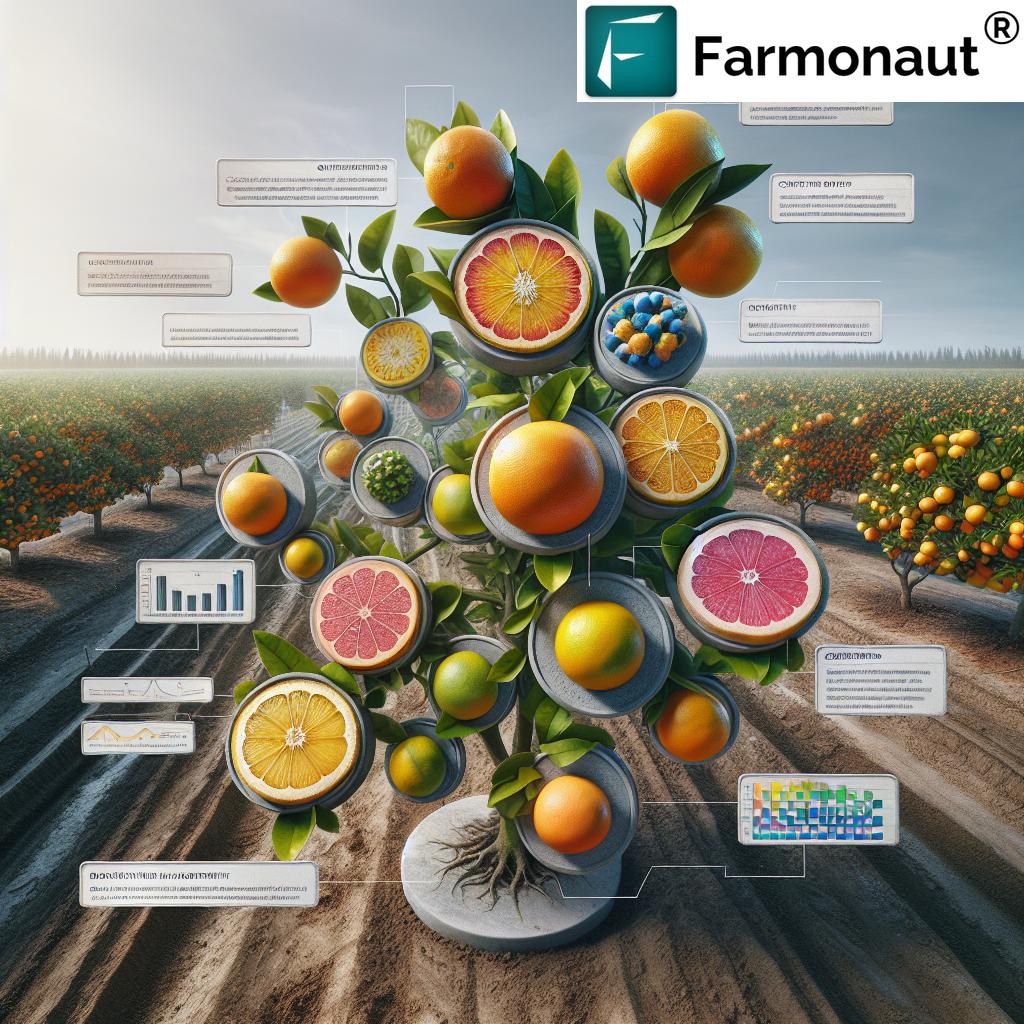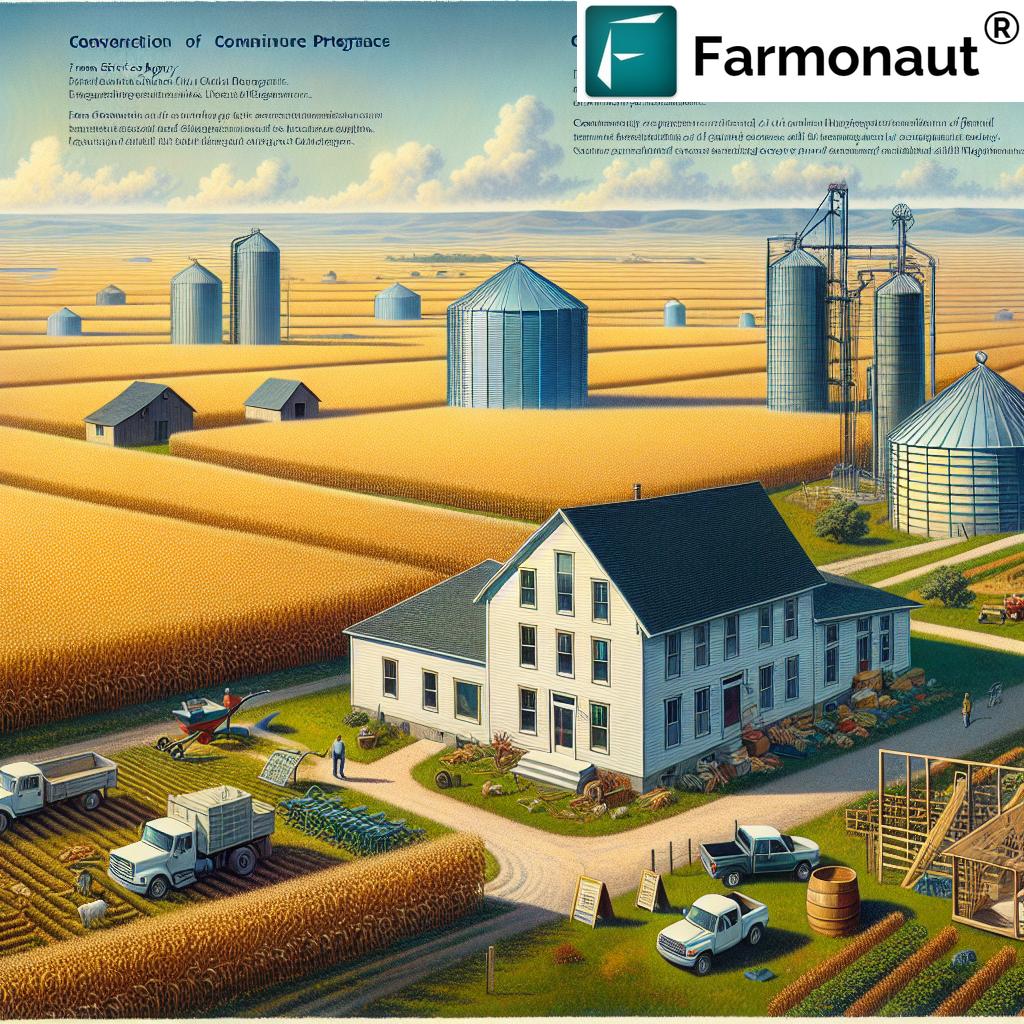Texas Citrus Industry: 7 Innovations Driving Resilience
“Texas citrus growers using AI-driven disease detection have reduced crop losses by up to 30% in recent years.”
A Historical Overview of the Texas Citrus Industry
The Texas citrus industry traces its roots back to the late 18th century, evolving into a dynamic agricultural sector predominantly centered in the Rio Grande Valley. Nestled in the subtropical zone of southern Texas, this region boasts ideal climate conditions and fertile soils, giving rise to the iconic, high-quality grapefruit and orange production Texas is recognized for today. Over time, citrus cultivation in Texas not only shaped the region’s agricultural landscape but also fostered economic growth, supporting countless jobs and enriching the state’s food heritage.
- Subtropical climate and alluvial soils support optimal fruit growth, particularly grapefruits and oranges.
- By the early 20th century, Rio Grande Valley fruit farming had established itself as the major hub for Texas citrus growers.
- The sector swiftly became a cornerstone of the state’s economy, driving growth and bolstering trade.
Despite the historic success, the industry’s journey has been punctuated by adversities such as harsh environmental challenges, disease threats, and persistent issues of water scarcity. Yet, its adaptive strategies and embrace of technological innovations have signaled resilience—a theme critical to securing the future of sustainable citrus farming in Texas.
Current Citrus Production and Economic Impact in Texas
The 2023–24 citrus season in Texas demonstrated a remarkable comeback. According to the latest data (citrusindustry.net):
- Citrus production Texas increased by 6% to 146,000 tons compared to the prior season.
- Orange production saw a 4% rise.
- Grapefruit production increased by 7%
- Total citrus production value was $84 million for 2023–24.
- Bearing citrus acreage: Down to 13,400 acres (from 15,100 previously).
These numbers highlight both the growth and the ongoing challenges in citrus acreage and market value, emphasizing the need for continual resilience and innovation as Texas citrus growers face mounting environmental and economic pressures.
Key Challenges Facing the Texas Citrus Industry
The Texas citrus industry continually navigates a complex array of challenges, each shaping production outcomes and the overall sustainability of farming in the Rio Grande Valley.
1. Environmental Adversities and the Impact of Winter Storms
-
The unprecedented winter storm Uri in February 2021 stands as a stark reminder of environmental vulnerabilities. The storm’s freezing temperatures devastated orange and grapefruit groves, resulting in:
- 33% decline in grapefruit production
- 62% decline in orange production
(Source: farmprogress.com)
- This severe damage demonstrates the ongoing impact of winter storms on crops in Texas—necessitating smarter adaptation measures.
2. Water Scarcity: The Core Issue Confronting Growers
- Chronic water scarcity plagues the sector—with the 1944 Treaty between the United States and Mexico stipulating an average annual delivery of 350,000 acre-feet. In reality, Mexico’s inconsistent compliance has created a pressing water supply deficit.
- December 2024 saw a payment from Mexico, but the water crisis threatens the future of Texas citrus.
- (Source: texasfarmbureau.org)
Water scarcity challenges for growers now drive the rapid adoption of water-conserving technologies and strategic irrigation practices.
3. Citrus Diseases, HLB, and Management Strategies
- Huanglongbing (HLB), or citrus greening, is the most devastating citrus disease threat in Texas. The Asian citrus psyllid, the principal disease vector, necessitates relentless control, monitoring, and early detection.
- (Source: thepacker.com)
- Robust citrus disease management strategies focus on integrated pest control, research-driven surveillance, and targeted treatment.
4. Declining Acreage and Labor Fluctuations
- Citrus acreage dropped from 15,100 acres to 13,400 acres in just one year (2023–24).
- Shifting labor dynamics, evolving disease pressures, and market uncertainties have forced growers to seek diversification and efficiency.
5. Economic Pressures and Global Competition
- Price fluctuations, rising production costs, and competition from other citrus-growing states (notably California and Florida) amplify the need for continuous efficiency and market diversification.
Despite these challenges, adaptation and resilience remain central to industry survival. Innovative strategies—technological and practical—are essential for future competitiveness and sustainability.
“Precision agriculture techniques have increased water use efficiency in Texas citrus farms by approximately 25%.”
7 Innovations Driving Resilience in the Texas Citrus Industry
To overcome adversity and ensure sustainable growth, the Texas citrus industry has embraced powerful innovations. Let’s explore the seven key technological and strategic advancements transforming the way Texas citrus growers approach water, disease, and economic risks.
-
1. Precision Agriculture & Satellite Crop Monitoring
The era of guesswork in farming has ended. Precision agriculture leverages cutting-edge tools and data-driven insights for optimal management of citrus groves.
- Satellite crop health monitoring empowers growers to analyze NDVI (Normalized Difference Vegetation Index), soil moisture, and plant stress across every acre.
- Targets irrigation precisely—vital for water scarcity challenges for growers.
- Supports sustainable citrus cultivation by optimizing input usage and minimizing waste.
- Farmonaut Large-Scale Farm Management is at the forefront of this shift. Our platform delivers real-time, comparative health analytics to help Texas citrus growers pinpoint irrigation needs, monitor disease hot spots, and maximize yield for every season.
-
2. AI-Driven Disease Detection and Monitoring
Artificial Intelligence is revolutionizing citrus disease management strategies—detecting the earliest visual signs of disease (like HLB) in orchards.
Farmonaut’s Jeevn AI Advisory System continually analyzes satellite imagery data to flag irregularities or symptoms. This enables:- Rapid intervention, reducing crop losses due to disease outbreaks by up to 30% in recent years.
- Data-driven prioritization of pesticide application and scouting operations.
- API developer access allows integration of disease monitoring tools directly into farm dashboards and cooperative networks.
-
3. Water Management, Drip Irrigation & Conservation
With water supply increasingly unpredictable due to both international treaty complexities and ongoing drought, sustainable water management is vital.
- Advanced drip irrigation systems optimize water delivery to plant roots, dramatically increasing efficiency.
- Sensor networks and predictive analytics allow growers to forecast water needs—foundational for Rio Grande Valley fruit farming.
- Farmonaut’s Carbon Footprinting tools enable farms to track and reduce water use, supporting compliance and transparent sustainability reporting.
-
4. Disease-Resistant Rootstocks and Diversified Cultivars
Genetically diverse and disease-resistant citrus rootstocks form a natural barrier to pathogens, nematodes, and Phytophthora. Notably, Swingle citrumelo rootstock displays proven resistance, making it a top choice for:
- Combating HLB citrus greening prevention efforts.
- Ensuring root health even in stressed or saline soils.
- Customizing fruit characteristics (size, flavor) for market expansion.
- (Reference: hortipm.tamu.edu)
-
5. Market Expansion, Value-Added Citrus Products & Cooperatives
Texas citrus growers mitigate economic swings by:
- Selling through marketing cooperatives to streamline harvesting, packing, and market access.
- Innovating with value-added products: juices, concentrates, citrus oils, and dried citrus.
- Reducing dependency on fresh fruit prices alone by capturing new consumer bases.
- Farmonaut’s blockchain-based product traceability enhances trust and transparency for premium Texas citrus products.
-
6. Integrated Pest and Resource Management Systems
Holistic management systems integrate pest, disease, fleet, and resource optimization. Core practices include:
- Automated, satellite-driven fleet route planning—ensuring timely harvest and minimization of fuel costs.
- Regular, real-time notification for pest outbreaks and environmental anomalies.
- Farmonaut’s Fleet and Resource Management delivers tailored logistics for diverse orchard operations.
-
7. Advanced Crop Insurance and Satellite-Based Loan Verification
Economic resilience hinges on smart financial risk management. Crop insurance processes and loan approvals now benefit from:
- Satellite-verified reporting of crop area and yield estimation.
- Streamlined claims and fraud reduction, enabling growers to focus on production and recovery after disasters.
- Farmonaut’s Crop Loan & Insurance Verification bridges the gap between citrus growers, insurers, and lenders—paving the way for greater access to agricultural credit and coverage.
Comparative Innovations Impact Table
| Innovation | Description | Challenge Addressed | Estimated Adoption Rate in Texas Citrus Farms (%) | Estimated Impact on Yield or Cost Reduction (%) |
|---|---|---|---|---|
| Precision Agriculture & Satellite Monitoring | Use of NDVI, real-time imagery and data analytics to optimize resource use and increase productivity. | Water scarcity, environmental unpredictability. | 45% | Yield ↑ 12%, Water Cost ↓ 25% |
| AI-Driven Disease Detection | AI scans orchards and detects early signs of HLB and other diseases to enable focused response. | HLB, disease outbreaks. | 35% | Crop Loss ↓ 30%, Input Use ↓ 10% |
| Drip Irrigation & Advanced Water Management | Fine-tuned irrigation at plant root zone; integrates sensors and predictive analytics to conserve water. | Water supply shortages, drought. | 55% | Water Use ↓ 28%, Cost ↓ 22% |
| Disease-Resistant Rootstocks & Cultivar Diversification | Cultivation of HLB-resistant and climate-adaptive citrus rootstocks tailored to local soils. | Citrus greening, nematode, and Phytophthora resistance; climate adaptation. | 40% | Yield Stability ↑ 15%, Mitigates Losses |
| Market Expansion & Value-Added Products | Production of juices, concentrates, and citrus products for diverse markets. | Economic volatility, fresh fruit market saturation. | 38% | Revenue ↑ 13%, Price Volatility ↓ |
| Integrated Pest & Resource Management Systems | Real-time monitoring and automation to optimize operational and input efficiency across farms. | Labor shortage, input waste, pest outbreaks. | 33% | Operational Cost ↓ 14% |
| Satellite-Based Crop Insurance & Loan Verification | Use of satellite data for insurance, claims, and credit access; reduces fraud and payment delays. | Economic risk, slow claim processing. | 22% | Claim Processing Time ↓ 40%, Credit Access ↑ |
The Future of Texas Citrus: Growth, Sustainability, and Technological Leadership
Drawing on its deeply-rooted agricultural heritage and spirit of resilience, the Texas citrus industry is poised to overcome adversity and thrive. The path forward will be shaped by:
- Continued innovation in satellite imagery, AI, and real-time crop and water monitoring.
- Integrated disease management—using predictive modeling, rapid diagnostics, and resistant cultivars to suppress HLB and other citrus diseases.
- Collaborative research between growers, plant breeders, and agricultural scientists to deliver tailored resistance and climate adaptation solutions.
- Increased focus on sustainable citrus cultivation—with responsibly managed water, carbon tracking, and conservation practices supporting both environmental stewardship and economic stability.
- Expansion into new product markets for Texas citrus—such as functional beverages, nutraceuticals, and eco-friendly packaging.
Innovation, partnership, and adaptability stand tall as the pillars supporting not only current recovery but long-term growth for the Texas citrus growers of the Rio Grande Valley and beyond.
Empowering Texas Citrus Growers: Farmonaut’s Technologies & Solutions
As the Texas citrus industry forges ahead, Farmonaut is proud to support sustainable fruit production, resilient adaptation strategies for growers, and precision management at every stage:
-
Satellite-Based Crop Monitoring
Our platform enables comprehensive field-by-field, orchard-by-orchard crop health monitoring via NDVI and multispectral imagery—putting actionable insight into every citrus grower’s hands, regardless of farm scale or location. -
Jeevn AI Advisory System
Leverages data to generate instant, tailored agronomic advice and early warnings for disease or pest risks, improving farm productivity and efficiency. -
Large Scale Farm Management App
Empowers commercial citrus enterprises and cooperatives to coordinate multiple plots, optimize logistics, and reduce input waste. -
Farmonaut API Access
Developers and agtech innovators use our API to incorporate live satellite weather and cropland data into their software or advisory platforms. -
Carbon Footprinting
Real-time carbon and water footprint tracking for compliance, sustainability reporting, and conscious farm management. -
Blockchain-Based Traceability Modules
Enhance transparency, safety, and trust for Texas citrus products in domestic and export markets. -
Fleet and Resource Management
Enables agribusinesses to manage orchard vehicles, crews, and harvest logistics efficiently. -
Crop Loan & Insurance Monitoring
Satellite evidence accelerates claims and increases loan eligibility for Texas growers facing natural disasters or operational risk.
From individual farm plots to industry-wide applications, modern technology and data are transforming citrus production. At Farmonaut, we make these advanced capabilities accessible and affordable—bolstering resilience, sustainability, and growth for Texas’s citrus sector.
FAQ: Texas Citrus Industry & Innovations
The Rio Grande Valley, thanks to its subtropical climate and fertile soils, accounts for the majority of orange and grapefruit production in the state.
Q2: What innovation is helping the most with water scarcity?
Drip irrigation systems and satellite-guided water management have led to more than 25% increase in water efficiency on Texas citrus farms. These methods target water directly to tree roots and monitor real-time needs via remote sensing.
Q3: How is HLB citrus greening being managed?
Early detection via AI-driven disease monitoring, regular orchard inspections, and the use of disease-resistant rootstocks (like Swingle citrumelo) form the backbone of citrus disease management strategies in Texas.
Q4: How do Texas citrus growers benefit from technological innovation?
Technology increases yield, minimizes input costs, improves sustainability, and opens new markets through traceability and value-added product production. This directly boosts resilience and economic stability for growers.
Q5: What is Farmonaut and how does it support citrus farmers?
Farmonaut offers affordable, satellite-powered farm management tools for crop health monitoring, AI-based advisory, blockchain traceability, and resource management. Our platform empowers Texas citrus growers to make informed decisions, optimize irrigation, improve disease detection, and ensure compliance with sustainable farming standards.
Q6: Can Farmonaut integrate with custom apps or co-op databases?
Yes! Our platform offers extensive API access and developer documentation, making it simple to embed satellite and weather data into custom agricultural software solutions.
If you’re in the Texas citrus industry or support citrus growers, staying ahead means embracing the very best new practices, data, and technologies—both at the orchard edge and in the digital realm.
Conclusion: Adaptation Strategies for Growers and The Resilient Future of Texas Citrus
Despite facing serious challenges—from impact of winter storms on crops, chronic water scarcity challenges for growers, and relentless threats of disease—the Texas citrus industry proves its tenacity season after season. Powered by innovation, a commitment to sustainability, and a shared community of solution-seekers (growers, researchers, technology partners like Farmonaut), the path forward is bright.
- Focus on sustainable citrus cultivation, adaptive technologies, and diversification will fortify the industry for years to come.
- Through precision agriculture, AI-powered monitoring, value-added product development, and transparent supply chains, Texas citrus will continue to be a vital force in the state’s agricultural economy.
- For growers ready to secure the next era of Rio Grande Valley fruit farming, innovation remains the engine of resilience and prosperity.


















